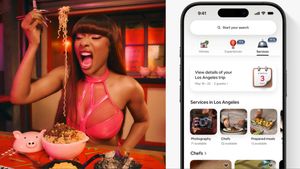Zolita's making music for a woman's world from a queer, feminist perspective. Through her new single and self-directed music video, "Fight Like a Girl," the 22-year-old California-born pop artist is dismantling misogyny by reclaiming the insult as a proud proclamation. "I've got a lot to say, no time to play (I'm coming for you)," she sings on the chorus. "I be standing tall, while I watch you fall. (You know I'm coming for you)."
As a devoted political activist and member of the LGBTQ community, Zolita's video champions diversity with a cast of women ranging in ages, races and sizes. Together, they wear red to symbolize power, as they surround Zolita in a femme manifestation circle, reflecting the artist's spiritual background. "My body, my choice, my rights, my voice," she sings, while the women harness their shared strength by dancing and projecting love.
Related | Gallery: Behind-the-Scenes of Zolita's 'Fight Like a Girl' Video
"Fight Like a Girl" is the first single off Zolita's as-yet untitled EP, due out October. The project followers her debut 2015 EP, Immaculate Conception, which included her viral tracks "Explosion" and "Holy," both of which have millions of views on YouTube. In keeping with her current approach, Zolita's previous work wrestled with queer sexuality and destroying the patriarchy--subject matter that's more important now, than ever.
We caught up with Zolita to learn more about her R&B-leaning alt-pop, and followed her behind-the-scenes of the "Fight Like a Girl" video.
OUT: How did Zolita begin and what do you see as its core mission?
Zolita: I've always been in love with music videos as an art form because they combine my two passions. So Zolita began as a creative outlet to make music videos. I'd describe my music as alt-pop, R&B-leaning. My core mission with Zolita is to make work that resonates with under-represented, marginalized communities.
How do you think you're queering pop music through Zolita?
I think by being an openly queer artist who actually makes queer art. There are so many artists in pop music who claim queerness (which is great), but they are so afraid to make art that is actually queer. They run away from using pronouns in lyrics or same-sex partners in music videos because they want to be palatable to the general public. I want to make pop music that queer and marginalized people feel like is made especially for them. Queer people have been connecting to and projecting their experiences onto heteronormative music their whole lives. Is it really so hard for me to ask straight people to do the same with my music?
In "Fight Like a Girl," you're reclaiming a statement that's historically been used to put down women. What were you hoping to accomplish?
That was the original premise of the song--take the negative connotation behind that phrase and turn it on its head. And with the video, I wanted to posit that "fighting like a girl" meant fighting with feminine magick, power of manifestation, and power of the mind, rather than physical violence.

Behind-the-Scenes
You include key phrases used by feminists against Trump, such as "My Body, My Choice." Did his campaign provoke you to make music?
100 percent. "My body, my choice" was one of the number one chants used at protests, and was the chant I and a lot of my femme friends felt the most moved and empowered by. I knew I wanted to include it in the song in some way. Trump's campaign definitely provoked me to make art that could resonate with the groups of people he was hurting and oppressing.
You've previously released an EP, Immaculate Conception, and now you're working towards another. What can we expect from the new work?
The new EP is slightly more pop than my first, and I think the songwriting is more concise. A wide range of my sonic influences are on the EP, so it definitely shows off different sides of what I can do musically. I think all of my work will always be inherently politically charged because I'm a queer female artist--but "Fight Like a Girl" is definitely the most overtly political song on the EP.
Talk us through the "Fight Like a Girl" video, which you self-directed. What's this process like for you being so hands on?
I knew I wanted the video to capture the spirit I felt at the Women's March on Washington. So I had this idea of a femme gathering/manifestation circle, and then the idea to tell several women's stories who end up at the circle. I can't imagine the process not being so hands on. I am almost too controlling for my own good and need to be a part of every step of the process. I write my scripts, co-produce, direct and generally co-edit all of my videos. I wanted the visuals for this video to really illustrate that this song is for everyone.

Behind-the-Scenes
There's a diverse array of women featured in the video, which is so important. How did you approach casting?
It was important to me that this video be filled with women I knew, had some sort of connection with, and was inspired by--women that are doing important things for their community. Goldie Luxe for example, the first woman in the video, is an incredible trans pop artist who I became friends with in my female cultural rebels class. My good friend Kaitlin, who's in the third storyline, is an outspoken assault survivor who uses makeup and dress-up to reclaim her body. Iman, the woman in the long red dress, is this incredible Egyptian witch and trans icon who I met at a french restaurant. She strutted in wearing a floor length green velvet cape and I knew I needed to know her. Sandy, the older woman, is an incredible language teacher and activist who my friend struck up a conversation with in Union Square Park. All of these women and their stories are what make the meaning of the song and the video.
Is there significance behind the color red? It's featured throughout.
I think red is a powerful, feminine color. It's the color of the blood we shed, It's the color that symbolizes the root chakra (foundation), and the color generally used in magick for spells involving personal empowerment, strength, courage and energy.
Why is it important to release a project like this under Trump's administration?
Right now it's extremely important for artists, especially female, POC and LGBTQ artists, to use their platforms to make art that challenges and speaks out against Trump's administration. We have not been censored (yet) and it is imperative that artists use their voices to speak for those whose voices are silenced.









































































